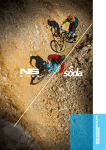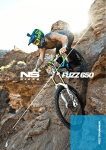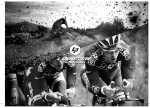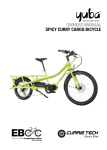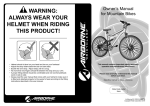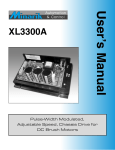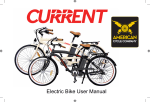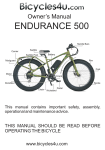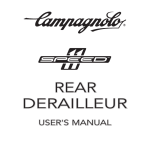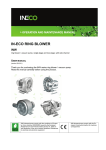Download Manual warranty
Transcript
M anual warranty WARNINGS AND IMPORTANT INFORMATION WARNING: This bicycle is not meant for public road use. It is meant for off road use only. This bicycle is designed for aggressive riding on rougher surfaces. You may use it for man-made dirt jumps, skate parks, ramps, as well as other places where you will need skill and bike control. Please note that by this type of riding unpredictable forces are put on a bicycle which may overload the frame, fork, or parts. The fact that you use a dirt jumping bike does not mean you have skills to jump. Therefore, to minimise the risk of serious or even fatal accidents, maintenance and assembly work on your bike should be carried out by an authorised bicycle workshop. IMPORTANT NOTICE: This manual is not intended as a comprehensive use, service, repair or maintenance manual. Please consult your dealer for advice and your dealer may also be able to refer you to classes, clinics or books on bicycle use, service, repair or maintenance. WARNING: If you intend to use the bike on public roads, you must prepare the bicycle to meet the local requirements for items such as lights and reflectors. Always follow all local traffic laws and regulations in force on public roads as well as off-road, including regulations about bicycle lighting, reflectors, licensing of bicycles, riding on sidewalks, laws regulating bike path and trail use, helmet laws, child carrier laws and other special bicycle traffic laws. WARNING: The bike box contains instructions for components made by third parties. You must study these carefully and follow the directions before riding your bike. For the info about recommended setup and maintenance of NS Bikes suspension frames please check the frame instruction. Frame tech manual is added to every suspension frame / bike. You can find it also on www.nsbikes.com. WARNING: Extreme riding is a very dangerous sport; it requires an amazing amount of skill. By engaging in this type of activity, you are accepting the risk of possible injury or even death. Even the best bike will not help you land a clean trick. Even the best protective gear will not guarantee complete safety. Remember that in this kind of riding, you can only trust your own abilities and you must accept the inherent risk. While extreme riding you can reach significant speeds and therefore face similar hazards and risks. Inspect your bicycle and equipment carefully and be sure that it is in perfect condition. If possible consult with area site personnel, expert riders and race officials on conditions and equipment advisable. Always wear appropriate safety gear, including an approved full face helmet, full finger gloves, body armour, bright, visible clothing that is not so loose that it can be tangled in the bicycle or objects at the side of the road or trail, shoes that will stay on your feet and will grip the pedals (make sure that shoe laces cannot get into moving parts, and never ride barefoot or in sandals). Always use protective eyewear, to protect against dirt, dust and bugs. INFORMATION : The maximum total weight allowed (rider + clothing + protective gear + backpack, luggage etc.) is 100 kg. WARNING: Never carry anything which obstructs your vision or your complete control of the bicycle, or which could become entangled in the moving parts of the bicycle. WARNING: The stem & handlebar must be connected firmly with the fork. Otherwise the whole steering system may fail and cause you to lose control of the bicycle. This may result in injury and death. WARNING: Do not extend the seat post above the minimum insertion mark. WARNING: Alloy handlebars should be replaced at least once a year because the can snap suddenly with no warning if submitted to fatigue stress for a prolonged period of time. WARNING: As with all mechanical components, the bicycle is subjected to wear and high stresses. Different materials and components may react to wear or stress fatigue in different ways. If the de- WARNING: Some of the service procedures require specialist tools and good mechanical skills. 2 sign life of a component has been exceeded, it may suddenly fail possibly causing injuries to rider. Any form of crack, scratches or change of colour in highly stressed areas indicate that the life of the component has been reached and it should be replaced. When replacing any components, especially the safety-critical ones, genuine spare parts complying with your bike specifications are to be used only. The manual provided by the part manufacturer contains full comprehensive details. TECHNICAL INFORMATION Make yourself familiar with the names of all the main parts of the bicycle by studying the diagram below: 24 5 7 7 6 8 9 4 8 23 22 3 13 1 10 12 21 18 13 14 17 20 19 21 2 16 10 15 12 14 11 1/ frame 2/ fork 3/ shock 4/ headset 5/ stem 6/ handlebar 7/ grip 8/ brake lever 9/ shifter 10/ brake 11/ tire (with tube inside) 12/ rim 13/ spoke 14/ hub 15/ pedal 16/ crankset 17/ chainwheel 18/ cassette 19/ chain 20/ rear derailleur 21/ chainguide 22/ seat clamp 23/ seat post 24/ seat 3 11 ASSEMBLY OF THE NEW BICYCLE This should always be carried out by the dealer where you purchased your bicycle. If you buy a bicycle that is disassembled, or only partially assembled the warranty will be void. Assembly should be done in your presence, in order to make the necessary adjustments correctly, such as saddle height, handlebar angle and stem height. It is also important to note that even if the bicycle is built up perfectly when new, it will need some additional adjustments a few weeks (or around 50km) later. You should visit your dealer and ask him to check the bicycle for you after this period. This is essential to keep your warranty. TOOLS REQUIRED 4mm,5mm, 6mm allen keys Philips head screwdriver 8mm, 15mm open end wrench Pliers with cable cutting ability Torx 25 wrench Torque wrench TOOLS REQU 4mm,5mm, 6mm allen 8mm, 15mm open end Torx 25 wrench philips head screwdrive To check if the frame size is safe, the rider should straddle the bike while wearing the kind of shoes which will be used for riding and stand straight with feet flat on the ground. The minimum distance between the rider's crotch and top tube should be 5 cm (approx. 2 inches) for a bicycle to be ridden on paved surfaces only, and at least 10cm (four inches) for bicycles to be used off road. This method of measuring the correct frame size does not apply to bicycles with step-through frames, or so called “lady” frames. In case of these frames, correct frame size should be determined first on a traditional diamond frame (so called “men's” frame). To check if the frame size is safe, the rider should straddle the bike while wearing the kind of shoes which will be used for riding and stand straight with feet flat on the ground. The minimum distance between the rider's crotch and top tube should be 5 cm (approx. 2 inches) for a bicycle to be ridden on paved surfaces only, and at least 10cm (four inches) for bicycles to be used off road. This method of measuring the correct frame size does not apply to bicycles with step-through frames, or so called “lady” frames. In case of these frames, correct frame size should be determined first on a traditional diamond frame (so called “men's” frame). CORRECT FRAME SIZE: 4mm,5mm, 6mm allen keys 8mm, 15mm open end wrench Torx 25 wrench philips head screwdriver TOOLS REQUIRED: 4 CORRECT FR To check if the frame si and stand straight with (approx. 2 inches) for a This method of measur In case of these frames sed for riding ould be 5 cm be used off road. “lady” frames. en's” frame). To check if the frame size is safe, the rider should straddle the bike while wearing the kind of shoes which will be used for riding and stand straight with feet at on the ground. The minimum distance between the rider’s crotch and top tube should be 5 cm (approx. 2 inches) for a bicycle to be ridden on paved surfaces only, and at least 10cm (four inches) for bicycles to be used o road. This method of measuring the correct frame size does not apply to bicycles with step-through frames, or so called “lady” frames. In TOOLS REQUIRED: 4mm,5mm, 6mm allen keys be decase of these frames, correct frame size should 8mm, 15mm open end wrench Torx 25 wrench termined rst on a traditional diamond frame (so called philips head screwdriver “men’s” frame). CORRECT FRAME SIZE: min. 5 cm paved surface min. 10cm - off road CORRECT FRAME SIZE GENERAL RIDING INFORMATION WARNING: When your bike is on a bike stand or it’s upside down, never put your finger or any other part of your body between the chain and the chainring when the wheel is spinning. This is especially important on single speed bikes with no derailleurs, because the chain is very tight. It is very easy to have your finger crushed or even amputated in such a situation! As mentioned, riding a bike, in particular an off-road one, can be dangerous. You must keep this in mind and be cautious at all times. See and be seen. Use lights and reflective clothing in low light conditions at all times. If the bike is to be used by your child, make certain that it always wears a suitable and approved bicycle helmet when using the bike. If your bike has suspension, please be noted that it can alter the way the bicycle performs. Never shift gears when pedalling in reverse, and do not back pedal directly after the shifter has been moved. This could make the chain jam causing serious damage to your bicycle. Riding with a wheel that has not been properly secured can make the wheel wobble or disengage from the bicycle resulting in serious injury or death. If your bike has been equipped with a clip-and-strap system (toe clips and straps) or clipless (step-in) pedals, make sure you know how they work; you should remember that special techniques and skills are to be used with such pedals. Note that in some bicycle models the user’s toe or toe clip may touch the front wheel when a pedal is all the way forward and the wheel is turned. This is normal, and your riding technique should take this into account (i.e. you should not turn the handlebar sharply to the left when your right foot is in the most forward position, or sharply to the right when your left foot is in the most forward position). If your bike has been equipped with platform type pedals that have metal pins attached, always ensure that pins are complete and kept in good condition. Check out the handling and response of the bike as well as the comfort. If you have any further questions, or if you have doubts about the proper functioning of your bike, consult your dealer before riding it again. Always conduct a pre-ride check (detailed information can be found further in this manual). Never ride the bicycle if you observe any technical problems or have any doubts about the proper functioning of any element in the bicycle. Keep the bike clean and well maintained. Make sure that your parts of the body as well as any other objects do not touch the sharp teeth of the chainrings, chainwheels, sprockets, chain, cranks, or spinning wheels of your bicycle. While using an off-road bike you are to comply with the following rules: you need to pay close attention and use the specific skills required in the changeable conditions and dangers associated with off-road riding. You should start slowly in uncomplicated terrain and develop your skills gradually. You shouldn’t ride your bike in remote areas unaccompanied. Even when riding in the company of others, always let someone know where you’re going and when you expect to come back. Always keep some sort of identification with you, so that you could be identified in case of an accident; also you should always have some cash for food, a cold beverage or an emergency phone call on you. It may be difficult to find help when you’re riding off-road. You should abide by the local regulations determining the places and methods of off-road riding, and respect private property. Respect the rights of the others you may be sharing the trail with — hikers, equestrians or other cyclists. You should reduce your impact on the environment to minimum. Thus, never cut your own trails or shortcuts through vegetation or streams, which could disturb the ecosystem. Don’t ride in mud or sludge or with unnecessary sliding as such behaviour could contribute to erosion. Always leave things as how you find them and take out everything that you bring in with you. In case of an accident or impact: first take care of your own situation - check yourself for injuries, and take the best possible care of them. Get medical help if neces- WARNING: Reflectors are not to be used as a substitute for required lights. You should abide by the local bicycle lighting regulations. Riding at times of poor visibility such as dawn, dusk, night or others, without a proper bicycle lighting system and reflectors constitutes a hazard and may cause serious injury or death. You should examine the bike lights and reflectors along with their mounting brackets regularly to make sure that they are clean, straight, unbroken and properly and securely mounted. 5 sary. Then, check your bike for damage. After a crash of any kind, you should have your bike thoroughly checked by your dealer. You must not use the carbon composite components, such as frames, wheels, handlebars, stems, cranksets, forks, brakes, etc. which have sustained an impact until they have been disassembled and thoroughly inspected by a qualified mechanic. The bicycle components can undergo unusual stress due to a crash or impact of other kind, causing their premature fatigue. Components suffering from stress fatigue can break suddenly and catastrophically, which may result in your losing control, serious injury or death. WARNING: Wet weather conditions dramatically increase the risk of an accident as they impair traction, braking and visibility, both for the cyclist and for other road users. Wet conditions dramatically reduce the stopping power of your brakes (especially rim brakes) as well as of the brakes of other vehicles sharing the road and your tires can lose their grip. Therefore, it is more difficult to control your speed and you may lose control easily in such conditions. To make sure that you are able to reduce speed and come to a stop safely in wet conditions, try to ride more slowly and start braking earlier and more gradually than you would under normal dry conditions. Always carry a pump, spare inner tube, patch kit, and a basic tool kit. You may need this in case of a flat tire or other common mechanical problem that is usually easy to fix if you have the right tools. If you need to patch your inner tubes, always make sure to follow the instruction manual provided by the tube repair kit manufacturer. Bikes sold in UK, Japan, Australia and other left-hand drive countries, the bikes should come with right lever operating the front brake and left lever operating the rear brake. In countries with right-hand drive traffic systems, the bikes should come with right lever operating the rear brake and the left lever operating the front brake. The user must check and make sure which lever is connected to which brake before the first ride because it is possible that the bicycle was imported from a country where brakes are set up differently to the standards applying in the country where the bicycle will be used. If your bicycle is equipped with gears, you can choose a gear combination that is most comfortable for the riding conditions. Gears will allow you to maintain a constant rate of pedalling. Use lower gears for going uphill and higher gears for going downhill. While shifting gears try to pedal with less effort so as to prevent early gear and chain wear and tear. Ask your dealer for more advice on this issue. Protect your bike against theft by purchasing a lock and never leaving your bike unlocked while unattended, even if you are going to leave it only for a short while. Bicycle Suspension If your bicycle has been equipped with any sort of a suspension system, make sure you read and follow the suspension set up and service instruction manual provided by the manufacturer. If you haven’t been provided the manufacturer’s instruction manual, contact your dealer or the manufacturer. WARNING: Failure to maintain, check and properly adjust the suspension system may cause suspension malfunction, in result of which you may lose control and fall. If your bike has been equipped with suspension, the increased speed you may develop will also increase the risk of injury. For example, when braking, the front of a bike with a suspension fork dip. You can easily lose control and fall if you are not prepared for this. Please, learn how to operate your suspension system safely. WARNING: Introducing changes in the suspension adjustment can alter the handling and braking characteristics of your bicycle. It is forbidden to change the suspension adjustment unless you are thoroughly familiar with the suspension system manufacturer’s instructions and recommendations; you should always check for changes in the handling and braking characteristics of the bicycle after the suspension has been adjusted by taking a careful test ride in a safe area. CAUTION: Watch out for the brakes - they can be powerful and activating them too aggressively can result in a crash. Learn to get a feel of the brakes practicing it on a side road or in an empty car park before you ride your bike for the first time. Thanks to the use of suspension the wheels can follow the terrain better, which can enhance control and comfort. This improved capacity may provide opportunity for riding faster, but you should be care- 6 ful not to mistake the enhanced capabilities of the bicycle for your own riding skills. Improving skills takes time and practice. visible rim wear marks constitutes a hazard and can cause serious injury or death. Too hard or too sudden application of the brakes can cause the wheel to lock up and make you lose control and fall. Applying the front brake too suddenly or excessively may result in the rider’s pitching over the handlebars, potentially causing serious injury or death. Bicycle brakes may be very powerful, especially disc brakes or linear-pull brakes. You should be extra careful while learning how to operate such brakes and take particular care while using them. Disc brakes can heat up extremely when their application is prolonged. Don’t touch a disc brake until it has had plenty of time to cool. Remember that brake pads in all brake types will wear out, which will ultimately reduce their efficiency. For information on how to operate and maintain your brakes and when to replace the brake pads see the brake manufacturer’s operation and maintenance manual. If you have not been provided with the manufacturer’s instruction manual, contact your dealer or the brake manufacturer. When replacing worn or damaged parts the manufacturer-approved genuine spare parts are to be used only. CAUTION: Not every bicycle can be safely retrofitted with certain types of suspension systems. Before planning to retrofit a bicycle with any suspension system, check with the bicycle’s manufacturer to make sure that the modification you are going to make is compatible with the bicycle’s design. Failure to do so can result in damage to the frame and your bicycle may be difficult to control due to improper geometry that results from the modification. IMPORTANT: make sure your wheels function properly before each use, check if the mounting bolts are secure, check that the freewheel engages correctly. If there is any malfunction of the hubs, they should not be used under any condition. In case of any doubt, consult an experienced bike mechanic. Rear hub axle bolts should be tightened alternately! Do not over-tighten the bolt on one side without counter tightening on the other! Brake controls and features It’s vital for your safety to learn and remember which brake is controlled by which brake lever on your bike. Acquaint yourself with the setup of your brakes by alternately squeezing the left and right brake lever and observing which brake lever activates the front brake, and which one activates the rear brake. You should be able to reach the brake levers with your hands and squeeze them easily. If you find out that your hands are too small to do so, you should consult it with your dealer before riding the bike. In some models the lever reach may be adjusted, or you may need a different brake lever design. If your mountain bike has been equipped with through axle front or back wheels, make sure that you have been provided with the manufacturer’s instruction manual, which you are to follow when installing or removing wheels with this system. If you are not sure what a thru-axle/through axle is, ask your dealer for information. It is crucial for you to understand what type of a wheel securing method is required on your bicycle, to know how to secure the wheels correctly, and how to apply the correct clamping force to secure the wheel safely. Ask your dealer to instruct you on how to remove and install the wheel on your bicycle properly, and provide you with any available manufacturer’s instruction manual. Operation of the braking system The bicycle braking system’s function is based on friction between two braking surfaces. To assure it’s proper functioning you should maintain the rims, brake pads, disc rotor and calliper clean and free of dust, dirt, grease, lubricants, waxes and polishes. There are special chemical cleaners available on the market designed specifically for cleaning these surfaces. Bicycle brakes have been designed to control the speed of your bicycle by reducing it or preventing the bicycle from moving. The maximum breaking force for each wheel is achieved just before the mo- Brakes There are two main types of bicycle brakes: rim brakes, operated by squeezing the wheel rim between two brake pads and disc brakes, operated by squeezing a hub-mounted disc between two brake pads. Both can be actuated by the rider squeezing a lever mounted on the handlebar. WARNING: Riding with brakes that have not been adjusted properly, worn brake pads, or wheels with a 7 ment the wheel stops rotating (“locks up”) and starts skidding. The instant it has begun to skid, the most of your bike stopping power and all directional control is lost. Therefore, it is necessary to learn how to slow down your bike and bring it to a halt smoothly avoiding a wheel lockup. To do so you should learn a progressive brake modulation technique so that you could be able to precisely and accurately control the amount of clamp force on a rotor with a given amount of lever input. Instead of pushing the brake lever abruptly, squeeze it slowly and gradually increase the braking force. The instant the wheel begins to lock up, slightly release pressure to keep it rotating, just short of lockup. You should learn how much brake lever pressure is needed for each wheel at different speeds and on different surfaces. Reducing the bike speed by applying one or both brakes will transfer the weight to the front wheel as the rider’s body continues at the speed at which it was going. Heavy braking will result in the transfer of weight around the front wheel hub, which may send the rider’s body flying over the handlebars. Greater brake pressure is needed for a wheel burdened with heavier load to lock up, whereas a wheel burdened with less weight will lock up with less brake pressure applied. Thus, when your weight is transferred forward when the brakes are activate, so you should move your body backwards in order to transfer weight to the back, simultaneously decreasing the rear braking force and increasing the front braking force. It is especially important when you are descending. The weight transfer is more evident on bikes equipped with a front suspension fork as it dips under braking and thus intensifies the weight transfer. To control your speed effectively and bring your bike to a halt safely you need to be in control of the wheel lockup and the weight transfer. You should practice braking and weight transfer techniques in safe places free from traffic and distractions. been moved. This could make the chain jam causing serious damage to your bicycle. We suggest you should find the gear relevant to your riding skills level, to do so check which gear will be hard enough for you to accelerate quickly and yet at the same time easy enough for you to be able to start your bike from a halt without wobbling. After you have found your “starting gear” go on to experiment with upshifting and downshifting to learn how to operate different gear combinations. Different conditions require different combinations, e.g. the combination of the largest rear and the smallest front gears will work on the steepest hills, while the combination of the smallest rear and the largest front gears will be used for reaching the greatest speed. Shifting gears in sequence is not necessary. At first we suggest you practice shifting gears on a location free from obstacles, hazards or other traffic, until you’ve built up your confidence. Learn to anticipate the need to shift, and shift to a lower gear before the hill gets too steep. Difficulties with shifting may indicate a mechanical adjustment problem, in which case you should contact your dealer for help. WARNING: If the derailleur does not shift smoothly, you should not shift further, it as it may be out of adjustment and the chain could jam, causing you to lose control and fall. Failure to shift to the next gear smoothly after moving the shift control by one click repeatedly indicates that the mechanism might incorrectly adjusted. You should have it checked by your dealer. If your bicycle has been equipped with a single-speed drivetrain system, the chain needs tension to make sure it doesn’t come off the sprocket or chainring. Check tightness of chain before every ride! (FIG. 1) The drive train is exposed to extreme loads. Any looseness or play in the drive train may cause damage to particular elements. Shifting gears/Gear shifting Shifting can be controlled by using various types of controls and methods: by using levers, twist grips, triggers, combination shift-brake controls and pushbuttons. Your dealer should explain what type of shifting controls your bike has been equipped with, and to show you how they should be operated. Before each ride check: crank set, rear hub, cassette and freewheel, pedals and chainrings - crank arm connection. The bicycle should be cleaned and lubricated with dedicated grease systematically. Chain lubrication depends on weather and terrain conditions. Water and mud speed up wear of the chain. Clean and lubricate chain after each ride in wet or muddy condi- CAUTION: Never shift gears when pedalling in reverse, nor back pedal directly after the shifter has 8 tions. The rear derailleur should shift gears smoothly. You can adjust gear shifting through a rear shifter barrel or by tensioning the cable under the cable anchor washer. Increasing the tension of the cable facilitates shifting to a lower gear, decreasing the tension of the cable facilitates shifting to a higher gear. Check if the pedals are properly threaded into the cranks. Looseness may cause damage of crank thread. Regularly check looseness in pedals to crank set connection. force on fasteners, nuts, bolts, screws on your bicycle so as to avoid components failure or damage, which can result in your losing control of the bike and falling. Using too little force may result in the fastener not holding securely, moving and undergoing fatigue. Applying too much force may cause the fastener to strip threads, stretch, deform or break. If you observe any problems at the pre-ride check, consult a professional bicycle mechanic instantly for advice. You can ride the bicycle again only after the problem has been resolved. CAUTION: It is crucial to apply correct tightening PRE-RIDE CHECK Before every ride you should always make a pre-ride check. It should include the following points: Clean the frame and fork and examine them CAREFULLY for any signs of cracks, corrosion, dents, paint peeling or other defects. If anything suspicious is found, contact your local bike dealer for a proper inspection. These are important safety checks and very important to help prevent accidents, injury and shortened product lifespan. Do not ride the bicycle if you see any defects in the frame and fork. Check if the brakes are working properly by testing their efficiency in a parking lot or on a side road. When the brake is applied with full force, the distance from the brake lever to the handlebar should be bigger than 2cm. Check the brake pads too - you should replace damaged and worn out elements and adjust immediately when improper function is noticed. To do this, contact your dealer or the closest authorised bike service. Remember that improper setup of the brake can cause serious injury or death. Follow the brake manufacturer’s instructions closely for setup and maintenance. The instructions are supplied in the box with every bicycle. If you are in doubt about their correct function, contact your local bicycle shop. recommended torque (see the manufacturer’s instruction manual). Brake reach In many bikes brake levers can be adjusted for reach. If your hands are small or if squeezing the brake levers is difficult for you, ask your dealer to adjust the reach or have shorter reach brake levers fitted. WARNING: With shorter brake lever reach, correct adjustment of brakes becomes more critical, full braking power should be applied within available brake lever travel. Brake lever travel inadequate for full braking power application can result in loss of control, which may cause serious injury or death. Check the brake cables and their housing for kinks, rust, broken strands, or frayed ends. If you notice any damage, you should ask a bicycle shop to replace the cables immediately. Damaged cables can seriously impede braking efficiency. If your bicycle has rim brakes, inspect the rim walls to check if they are not excessively worn out by the brakes. A groove made by manufacturer on the sidewall of a rim should always be visible. On rims without a groove/safety mark it is important to check if f the braking surface has not become deformed by the brake pads. The rims should be replaced as soon as a visible deformation of the rim surface occurs. Control position adjustments It is possible to adjust the angle and position of brakes and shift controls on the handlebars. Ask your dealer to make the necessary adjustments for you. If you choose to adjust the control lever angle on your own, be sure to re-tighten the clamp fasteners to the For your information: in some jurisdictions there are 9 requirements to determine the minimum leg-length dimension (clearance between the rider’s crotch and the top tube of the bike when stood in front of the saddle) in the manual. This does not apply to all bicycles, yet the so called stand over height constitutes a basic element of bike fit and plays an important role, especially when dismounting the bike quickly. While determining the correct stand over height you should straddle your bike while wearing the kind of shoes which you are going to wear while riding, and bounce energetically on your heels. Your crotch touching the frame means that the bike is too big for you. You should not ride the a bike. The minimum stand over height clearance for the bike ridden on paved surfaces only and never taken off-road should be 5 cm (approx. 2 inches). The minimum stand over height clearance for the bike to be ridden on unpaved surfaces should be 7.5 cm (approx. 3 inches). The minimum stand over height clearance for the bike to be used off road should be 10cm (four inches) or more. Stand over height does not apply to bicycles with step-through frames. In such bicycles the range of the saddle height determines the limiting dimension. Make sure you are able to adjust the position of your saddle as shown in this manual herein above without exceeding the limits set by the height of the top of the seat tube and the minimum insertion or maximum extension mark on the seat post. Remember that toe-clearance may vary according to any modifications introduced to tires or cranks. wards. There should be no play between the frame and fork). If any play is found contact your local bike shop. Do not attempt to make any adjustments yourself. If you are confident that you can do this yourself then adjust the steering system according to the following instructions: loosen the steer clamp binder bolts. Adjust preload until no binding or looseness are present in the headset. (FIG.3) Align the stem with the front wheel and now tighten the steer clamp binder bolts alternately, in small increments. Once again, check for headset play. If play exists, loosen the steer clamp, pinch bolts, and tighten the top cap anchor bolt 1/16th of a turn. Align the stem, and retighten the pinch bolts Remember to tighten both bolts alternate (FIG.4). Repeat until proper adjustment made. All parts of the stem should be regularly checked for damage or cracks. If you find anything suspicious, contact an experienced bike mechanic immediately. A defective steering system can cause serious injury or death. Check if the wheels are straight (lift the bike and spin each wheel - the rim should not move more than around 1mm to each side). Check if all the spokes are tight by running your hand around each wheel on both sides. Contact your bicycle dealer to resolve any problems. Do not attempt to ride a bicycle with wheels that are not straight or with spokes that are loose, as it is a dangerous to your health and life. Check if the tires are properly inflated (see the prints on the side walls for instructions about the optimum pressure: usually 3.5 – 4.5 bar depending on terrain and weather conditions). Use a proper bicycle pump with a pressure gauge to achieve the correct pressure. Check the overall conditions of the tires, if they are damaged, torn or worn out you should replace them before riding. Using worn or damaged tires is dangerous to your health and life. Make sure tires are correctly inflated and are in good shape. Spin each wheel slowly and look for cuts in the tread and sidewall. Replace damaged tires before riding the bike. Fork Proper maintenance is essential for long life and optimal fork function. Lack of maintenance may result in faster wear and may lead to malfunction causing serious injury or death. If you are not sure how to maintain the fork, you should consult your dealer to help you with your maintenance requirements. Things to check before each ride: a) Check wheel axle to fork connection, b) Check brake clamp to fork connection, c) Check headset looseness, d) Check stem Steering system. The steering system includes: handle bar, stem, headset and fork. All elements should be connected firmly for riding safety. WARNING: Proper assembly and functioning of the steering system is critical for your safety!!! Your dealer is responsible for proper assembly of the steering system for you. If you wish to make any adjustments yourself, be warned that incorrect setup can be very dangerous and we always advise you to seek professional advice for this! Check the connection between the handlebars and stem. Try pushing the handlebars up and down - there should be no movement between these two elements. If there is any, it is necessary to tighten the stem bolts (FIG 2). Check the headset for play (stand next to the bicycle, apply the front brake and push forwards and back- 10 to handlebar connection, e) Clean fork stanchion tubes, f) Check general fork condition (take special note of any cracks or deformations). Do not ride if any defects noticed! For information about servicing suspension forks mounted on the bike it is necessary to follow manufacturer’s instructions closely. The user manual for the suspension forks are supplied in the box with every bicycle. Check wheel axle to fork connection - this is critical for your safety. If you have axle nuts they should be tightened according to the manufacturer’s specification. If you have a quick release make sure that it is set to the CLOSED position, and that there is a reasonable amount of resistance when pushing the lever (FIG.5). The amount of resistance can be adjusted by turning the knob on the opposite side of the lever when the lever is in the open position. Never leave the quick release loose, and do not try to turn it like a screw. Reference bolt tightening torque values (please always refer to the manufacturer’s instruction manual first, the values shown below do not apply to ALL types of components that may be mounted on the bicycle): Bolt type: Tightening torque (N-m): Stem steer tube bolt 12 Stem handlebar bolts 10 Front hub axle bolts 17 (for 10mm axle hubs) Rear wheel bolts/nuts 35 MTB crankset to bottom bracket bolts 40 3pcs crankset to bottom bracket bolts 12 FIG. 1 FIG. 2 FIG. 4 FIG. 3 FIG. 5 11 3pcs crankset pinch bolts 12 Seat binder, Seat post clamp bolts M5 10 Seat binder, Seat post clamp bolts M6 12 Pedals 25 Brake calliper screws to frame and fork 10 Shifting lever, Brake lever 3 Disc brake screws to hub 6.0 Rear derailleur: main fixing bolt 10 Rear derailleur: cable fixing bolt 5 ADJUSTMENTS It is possible to make some adjustments to your bicycle that will influence your riding position. These adjustments can make a great difference to riding pleasure, speed and safety - so unless you are a very competent cyclist and mechanic, do not attempt to execute any of these adjustments yourself. Seek advice at your local bicycle shop. The basic adjustment points are as below: Adjusting saddle height. This should be carried out using an 5 mm hex wrench. Unscrew the seat binder bolt, set the saddle at a certain height, then re-tighten the bolt and sit on the bicycle. Repeat until you find the best position. The tightening torque of the seat binder should be around 12Nm Check (FIG 6.) FIG. 6 FIG. 7 WARNING: Never extend the seat post above the minimum insertion mark that can be found on the lower part of the seat post! experimenting with various combinations. A general rule is that the saddle should be set more or less in the central position, and should be tilted slightly to the rear (the nose should be pointing up around 3 -5 degrees). This will put more body weight on the saddle and take of some pressure from your hands. Adjusting the rail saddle position. This should be done using a 5mm or 6mm hex wrench. When you loosen this bolt(s), it is possible to change the angle of the saddle and it’s fore and aft position (FIG 7). Try 12 MAINTENANCE AND PERIODICAL CHECKS Take care of your bicycle, and you will enjoy it for a longer time. Also take some time to periodically inspect the bicycle in more detail - this is important for your safety. Here is some basic information. A good rust inhibitor should be applied to the inside of your frame at least once a year. Regular cleaning will remove salt and other chemicals from the surface of your bicycle minimising the likelihood of external corrosion. It is very important that paint chips and scratches get touched up as soon as possible with factory touch-up paint or nail polish. Prior to painting, make sure that the surface is free of rust, clean and dry. The frame does not require any lubrication with the exception of the inside of the seat tube. Periodically inspect the fork for any signs of damage. If you suspect it may be broken, bent, cracked do not use it. Inspect if the steer tube and fork blades are straight and dropouts for cracks or damage. Do not ride on the damaged fork - it may cause serious injury or death. Note: The handlebars should be replaced at least once a year as they are submitted to fatigue. Check the cranks for play (hold the bike with one hand, and the pedals with the other and look for play by trying to push the pedals from one side of the bike to the other). If any play is found contact your local bike shop. Periodically check hubs for play and have the bearings adjusted if necessary by professional bicycle mechanic. The bearings should be lubricated about once a year. Keep your chain cleaned and lubed. This is especially important if you ride often in wet conditions. Use proper bicycle chain lubricants, WD-40 is not one of them! WARNING: As for all mechanical components, the bicycle is subject to wear and tear as well as high stresses. The reaction of various materials and components to wear or stress fatigue may differ. Having exceeded the life expectancy of a component may result in its sudden failure, possibly causing injuries to the rider. Any forms of breaks, cracks, scratches or changes of colouring in highly stressed areas indicate that the life of the component has been reached and it should be replaced. NOTE Enclosing any other relevant information will be at the discretion of the manufacturer. NS BIKES WARRANTY the product is purchased. This purchase must be documented with the cash receipt plus filled in warranty card (which includes the following information: date of purchase, serial number of frame, name of bike model, customers name and name of dealer). 1. 7ANNA sp. z o.o. sp. k. (hereinafter on referred to as 7ANNA), manufacturer of NS Bikes, warrants all it’s new hardtail bicycles against defects in materials and workmanship for a period of 1 year. All new full suspension frames and all new steel allmountain and enduro hardtail frames have a 3 year warranty. 4. The warranty applies only to the original owner and is not transferable. 2. If any defects are noticed in the bicycle, the Customer must stop using the product immediately and should report this to the dealer that sold it within 14 days. Using a damaged bicycle will void the warranty, lead to more extensive damage and may pose a serious hazard to the rider’s health and life. 5. Claims under this warranty should be made through the dealer where the bicycle was purchased. 6. The bicycle should be submitted to a mandatory check-up between the 3rd and 5th week from date of purchase (or after 50km of riding) to an authorised bicycle dealer. The confirmation of this 3. The warranty period starts from the day when 13 check-up should be documented in the warranty card. Failure to do this will void the warranty. bike. Such damage won’t be covered by the normal warranty, however 7ANNA offers the possibility to replace the product for 50% of the original suggested retail price under the Crash Replacement policy. The conditions for this are: Crash Replacement applies to components made by 7ANNA that are mounted in the bikes, all NS Bikes hardtail frames for a period of 1 year and all full suspension and steel enduro frames for a period of 3 years from the date of purchase, 7ANNA reserves the right to deny Crash Replacement without further explanations, Crash Replacement does not apply to parts damaged in other situations than in riding (for example Crash Replacement will not cover a part that has been damaged during shipping), Crash Replacement does not apply to complete bikes. It only applies to components made by 7ANNA that are mounted in the bikes. 7. The warranty is valid only if the bicycle is sold by an authorised dealer in a ready-to-ride condition. 8. If a certain part of the bicycle will require replacement under this warranty, parts that are similar in function to the originals shall be provided. It may not always be possible to provide parts that are identical. The decision if a broken part requires replacement or repair will be made by the dealer who sold the bicycle. The dealer’s decision will be conclusive and binding. 9. The warranty does not cover normal wear and tear of tires, chains, brake pads, bearings, cogs and chainrings. Wheel truing, lubricating, brake adjustment, drive train adjustment and other typical maintenance procedures are not covered by the warranty and must be conducted by a professional bicycle workshop at the cost of the customer. 14. This limited warranty does provide the original owner with certain legal rights and recourse and the original owner may possess other rights or recourse, depending on the state, jurisdiction, country, or province. Please be informed that this is a final statement of the 7ANNA and all the remedies available to the original owner are stated herein. 7ANNA does not allow or authorise any entity (including authorised dealers) to extend any other express or implied warranties on its behalf. An original owner agrees that 7ANNA’s liability under this warranty under no circumstances shall be greater than the original purchase price. In no event shall 7ANNA be liable for incidental or consequential damages. All other remedies, obligations, liabilities, rights, warranties, express or implied, arising from law or otherwise, including (but not limited to) any claimed implied warranty of merchantability, any claimed implied warranty arising from course of performance, course of dealing or usage of trade, and any claimed implied warranty of fitness, are disclaimed by 7ANNA and waived by the original owner. Some states, jurisdictions, countries, and provinces do not allow some or all of the limitations set forth herein, or the exclusion or limitation of incidental or consequential damages. If any provision is found unenforceable, only that provision shall be stricken and all others shall apply. 10. The warranty does not cover: labor charges for replacing parts, paint and decals, problems that result from excessive loads occurring during extreme riding or from incorrect riding technique. The warranty does not cover: the cost of travel or shipment to and from an authorised dealer. Such costs, if any, shall be borne by the original owner. 11. This warranty is void if: the warranty card is filled in incorrectly or incompletely, any modifications have been made to the bicycle by the customer, damage has been caused by external parts that have been incorrectly assembled on the bicycle, the product had not been used, maintained or repaired according the manufacturer’s instructions, the bicycle had been sold disassembled, or only partially assembled, the product was transferred to any third party. 12. Directions on how to deal with warranty cases shall be provided by the distributor of the product in the region where it was purchased. 13. The Crash Replacement Warranty covers damage resulting from crashing, or excessive loads generated by things like casing jumps or throwing the 14 PROOF OF PURCHASE – WARRANTY CARD Dealer’s stamp Bike, model: ..................................................................................................................................................................................... Frame serial number: ................................................................................................................................................................... Fork serial number (if any): ....................................................................................................................................................... Price: ................................................................................................................................................................................................... Date of purchase: .......................................................................................................................................................................... I certify that I am acquainted with the actual specification of the bicycle (this can be slightly different than that published by the distributor). Buyer’s signature: ........................................................................................................................................................................ Dealer’s signature: ........................................................................................................................................................................ 15 handmade in Europe

















